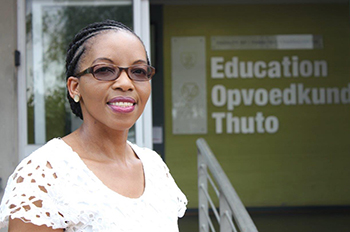
Mots’elisi Malebese, postdoctoral Fellow of the Faculty
of Education at the University of the Free State (UFS) tackles
Grade 4 literacy challenges.
Photo: Rulanzen Martin
Imagine a teaching approach that inculcates richness of culture and knowledge to individual learners, thus enhancing equity, equality, social justice, freedom, hope and fairness in terms of learning opportunities for all, regardless of learners’ diversity.
This teaching strategy was introduced by Mots’elisi Malebese, postdoctoral Fellow of the Faculty of Education at the University of the Free State (UFS), whose thesis focuses on bringing together different skills, knowledge and expertise in a classroom environment in order to enhance learners’ competence in literacy.
A teaching approach to aid Grade 4 literacy competency
Titled, A Socially Inclusive Teaching Strategy to Respond to Problems of Literacy in a Grade 4 Class, Malebese’s post-doctoral research refers to an approach that improves listening, speaking, reading, writing, technical functioning and critical thinking. Malebese, who obtained her PhD qualification in June this year, says her research confirmed that, currently, Grade 4 is a bottleneck stage, at which learners from a low socio-economic background fall behind in their learning due to the transition from being taught in their home language to English as a medium of instruction.
Malebese, says: “My study, therefore, required practical intervention through participatory action research (PAR) to create conditions that foster space for empowerment.”
PAR indoctrinates a democratic way of living that is equitable, liberating and life-enhancing, by breaking away from traditional teaching methods. It involves forming coalitions with individuals with the least social, cultural and economic power.
Malebese’s thesis was encouraged by previous research that revealed that a lack of readiness for a transitional phase among learners, teachers’ inability to teach literacy efficiently, and poor parental involvement, caused many learners to experience a wide variety of learning barriers.
A co-teaching model was adopted in an effort to create a more socially inclusive classroom. This model involves one teacher providing every learner with the assistance he or she needs to succeed, while another teacher moves around the room and provides assistance to individual learners.
“Learners’ needs are served best by allowing them to demonstrate understanding in a variety of ways, because knowledge is conveyed and accomplished through collaborative work,” Malebese said.
She believes the most important benefit of this model is assuring that learners become teachers of their understanding and experiences through gained knowledge.
Roleplayers get involved using diverse expertise in their field
Teachers, parents and several NGOs played a vital role in Malebese’s study by getting involved in training, sewing and cooking clubs every weekend and during school holidays. English was the medium of teaching and learning in every activity. A lodge, close to the school, offered learners training in mountain biking and hiking. These activities helped learners become tour guides. Storyteller Gcina Mhlophe presented learners with a gift of her latest recorded storytelling CD and books. Every day after school, learners would read, and have drama lessons once a week.
AfriGrow, an organisation that works with communities, the government and the corporate sector to develop sustainable community-driven livelihoods through agricultural and nutrition programmes, provided learners with seedlings, manure and other garden inputs and training on how to start a sustainable food garden. The children were also encouraged to participate in sporting activities like soccer and netball.
“I was aware that I needed a large toolbox of instructional strategies, and had to involve other stakeholders with diverse expertise in their field,” Malebese said.